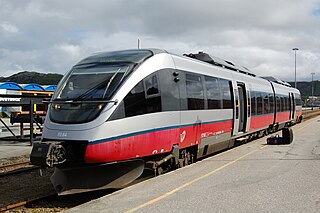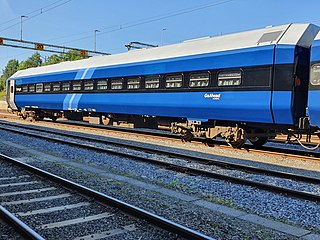The Airport Express Train is a Norwegian high-speed airport railway service connecting Oslo Airport to Oslo Central Station in nineteen minutes. Run by Flytoget AS, it operates on the high-speed Gardermoen Line using sixteen GMB Class 71 electric trains. Normal service frequency is once every ten minutes, with five of the services each hour continuing westwards beyond Oslo Central. The extended services serve nine stops within Greater Oslo and take up to 60 minutes.

Vygruppen, branded as Vy, is a government-owned railway company which operates most passenger train services and many bus services in Norway. The company is owned by the Norwegian Ministry of Transport. Its sub-brands include Vy Buss coach services, CargoNet freight trains and the Swedish train transport company Tågkompaniet. In 2009, NSB carried 52 million train passengers and 104 million bus passengers. On 24 April 2019, passenger train and bus services were rebranded as Vy.

The Vestfold Line is a 137.79-kilometer (85.62 mi) railway line which runs between Drammen and Eidanger in Norway. The line connects to the Drammen Line at the northern terminus at Drammen Station and continues as the Bratsberg Line past Skien Station. The line is exclusively used for passenger trains, which are provided by the Norwegian State Railways, which connect northwards to Oslo and south-westwards to Grenland. The 13-kilometer (8.1 mi) section from Eidanger to Skien is often colloquially included in the Vestfold Line.The standard gauge line is electrified at 15 kV 16.7 Hz AC and has twelve remaining stations. The Vestfold Line runs through the coastal region of Vestfold and serves major towns including Holmestrand, Tønsberg, Sandefjord and Larvik, as well as Sandefjord Airport, Torp.

The Ofoten Line is a 43-kilometre (27 mi) railway line in Narvik, Norway. It runs from the Port of Narvik to Riksgränsen on the Norway–Sweden border, where the line continues as the Ore Line via Kiruna and Gällivare to Luleå. The Ofoten Line is single track, electrified at 15 kV 16.7 Hz AC and has seven stations. The line only connects to the rest of the Norwegian railway network via Sweden. The main traffic is up to 12 daily freight trains operated by Malmtrafik that haul iron ore from Sweden to Narvik. In addition, CargoNet operates container trains, branded as the Arctic Rail Express (ARE), and SJ operates passenger trains, including a night train to Stockholm.

NSB El 18 is a class of 22 electric locomotives built by Adtranz and Swiss Locomotive & Machine Works (SLM) for the Norwegian State Railways (NSB). The class is a modification of the Swiss Federal Railways Re 460 locomotive and built at Adtranz Strømmen in 1996 and 1997. The class remains the only mainline electric locomotive used by NSB, and is predominantly used on some intercity services and all night trains on the Bergen Line, Dovre Line and Sørland Line, as well as some regional trains.

NSB Class 73 is a class of 22 electric multiple units built by Adtranz for the Norwegian State Railways. The four-car trains were modifications of Class 71, which was again based on the Swedish X2. The A-series consists of 16 intercity trains; they were delivered in 1999 and 2000 and are used on the Bergen, Dovre and Sørland Lines. The intercity service was branded as Signatur until 2003. The B-series consists of six regional trains delivered in 2002 and used on the Østfold Line. The regional trains were originally part of the Agenda concept. The trains have a power output of 2,646 kilowatts (3,548 hp) and a maximum speed of 210 km/h (130 mph). They have an overall length of 108 meters (354 ft) and have a capacity for 208 seated passengers in the A-series and 250 in the B-series. The trains have a tilting mechanism allowing for faster travel through curves.

NSB Di 6, later designated ME 26 and DE 2700, is a class of twelve diesel-electric locomotives built by Siemens for the Norwegian State Railways (NSB). The prime mover provides a power output of 2,650 kilowatts (3,550 hp), a starting traction effort of 400 kilonewtons (90,000 lbf) and a maximum speed of 160 kilometres per hour (99 mph). They have a Co′Co′ wheel arrangement. The bidirectional locomotives were designed for use with both passenger and freight trains.

Class 93 is a tilting two-carriage diesel multiple unit used by SJ Norge for passenger trains on non-electrified stretches of the Norwegian railway network. Used on the Nordland Line, the Røros Line and the Rauma Line, they were purchased to replace the aging Di3 locomotive-hauled trains. The Class 93 was produced by Bombardier, and is part of the Talent family. Fifteen units were delivered between 2000 and 2002.

NSB Class 71 is an electric multiple unit used by Flytoget for the Airport Express Trains on the Gardermoen Line of Norway. Sixteen three-car train sets were built by Adtranz Strømmen between 1997 and 1998. The units are capable of 210 km/h (130 mph), connecting Oslo Central Station and other stations in Metropolitan Oslo to the Oslo Airport, Gardermoen, along Norway's only high-speed railway.

NSB Class 72 is a class of 36 electric multiple units built by AnsaldoBreda for the Norwegian State Railways. Delivered between 2002 and 2005, the four-car units operate on the Oslo Commuter Rail and the Jæren Commuter Rail. The trains have a capacity of 310 passengers and the 2,250 kilowatts (3,020 hp) motors allow a maximum speed of 160 kilometres per hour (99 mph). The trains were ordered in 1997, with original delivery dates in 2001 and 2002. NSB also had an option to buy 40 additional units. The first units were not delivered until 2002, and by 2004, still half the trains were not in use. Faults included rust, too heavy train weight, and signaling problems. After the initial troubles, the Class 72 has been a highly successful train for NSB and well liked by the maintenance workers.

Norske tog Class 92 is a class of 15 diesel multiple units built by Duewag for the Norwegian State Railways (NSB). The two-car trains were delivered in 1984 and 1985, and were put into service on the Røros Line and southern part of the Nordland Line—which later became the Trøndelag Commuter Rail. Later, they also entered service on the Meråker Line as part of the international Mittnabotåget service. Previously, the trains were also used on the Solør Line, further north on the Nordland Line and on the now electrified Arendal Line. In 2000, a unit was involved in the Åsta accident; which killed 19 people. The trains were refurbished in 2005 and 2006, and NSB plans to replace them by around 2019. Each twin unit seats 168 people, is 49.45 meters long and weighs 92 tonnes. The front car is powered with two electric motors, giving a power output of 714 kilowatts (957 hp) and a maximum speed of 140 kilometers per hour (87 mph).

NSB Class 70 is a four-carriage electric multiple unit operated by Vy on medium distance trains around Oslo. They are operated on the Dovre Line between Oslo and Lillehammer / Dombås and on the Vestfold Line, operating the regional service between Lillehammer and Larvik / Skien.
There are three basic types of Norwegian railway carriage used commonly by NSB on the Norwegian railway system, the Class 3, Class 5 and Class 7 series. As of 2005, the carriages are hauled by NSB El 18 engines on the main electrified stretches and NSB Di 4 engines on non-electrified lines.

NSB Di 3 is a class of 35 diesel-electric locomotives built by NOHAB for the Norwegian State Railways (NSB). The class was built between 1954 and 1969, and delivered in two series, Di 3a and Di 3b. They are based on the Electro-Motive Division F7 and are equipped with EMD 567 engines. They have a distinct bulldog nose and were numbered 602–633 (a-series) and 641–643 (b-series). The locomotives had a prime mover that gives a power output of 1,305 kilowatts (1,750 hp). The a-series has a Co′Co′ wheel arrangement, while the b-series has (A1A)(A1A). The b-series has higher top speed, but lower tractive effort.

Iore, often stylized IORE, is a class of 34 electric locomotives built by Adtranz and its successor Bombardier Transportation for the Swedish mining company LKAB's railway division Malmtrafik. The class is a variation of Adtranz's Octeon modular product platform, thus related to Bombardier's later TRAXX platform. The locomotives haul iron ore freight trains on the Iron Ore Line and Ofoten Line in Sweden and Norway, respectively. The 8,600-tonne 68-car trains are hauled by two single-ended Co′Co′ locomotives, each with a power output of 5,400 kW (7,200 hp). Each operates with 600 kilonewtons tractive effort and has a maximum speed of 80 km/h (50 mph). Delivery of the first series of 18 locomotives was made from 2000 to 2004, and they replaced some of the aging Dm3 and El 15 units. In 2007, eight more vehicles were ordered, with production to be completed by 2011, by which time, another four double units were ordered. These units were scheduled to be delivered from 2013 to 2014.

The Trøndelag Commuter Rail is a commuter train service operating in Trøndelag county, Norway. It was operated by Vy with Class 92 diesel multiple units, until 7 June 2020 when SJ Norge took over the contract until 2030. The service provides a commuter service connecting Trondheim to its suburbs, between towns in Innherred and as an airport rail link for Trondheim Airport, Værnes. Although passenger services have operated along the lines since 1864, the commuter train was created with an increase of service with existing rolling stock in 1993. In 2019, the system was used by 1.4 million passengers.

NSB Class 66 was a three-car electric train used by the Norwegian State Railways for express trains on the Østfold Line to Halden and Gothenburg, and the Sørlandet Line to Kristiansand and Stavanger. The four multiple units were built by Skabo Jernbanevognfabrikk, with motors from Norsk Elektrisk & Brown Boveri, and delivered in 1945–46. They were originally named Class 106, but this was changed in 1956. The trains received the numbering BFM 66.01–04, B 66.31–34 and BS 66.61–64.
Ofotbanen Drift AS, trading as Ofotbanen, was a Norwegian passenger and freight railway company. The company operated a fleet of six locomotives, three multiple units, 22 passenger and 48 freight cars. The sole service was the passenger train Unionsexpressen between Oslo and Stockholm; it had previously offered freight haulage on contract.

LKAB Malmtrafik, earlier Malmtrafik i Kiruna AB (MTAB), is a Swedish railway company which operates the iron ore freight trains on the Iron Ore Line and the Ofoten Line. MTAB is a wholly owned subsidiary of the mining company Luossavaara–Kiirunavaara (LKAB). In Norway, operations are handled by the subsidiary Malmtrafikk AS (MTAS). Malmtrafik hauls ore from LKAB's mines in Kiruna, Malmberget and Svappavaara to the ports of Luleå and Narvik, the latter located in Norway. The company owns 28 Iore locomotives and 750 hopper cars. Each train is 68 cars long and weighs 8,600 tonnes, allowing the company to transport 33 million tonnes per year.

NSB WLAB-2 or WLAB2 is a class of twenty sleeping cars built by Strømmens Verksted for the Norwegian State Railways (NSB). They serve as the sole sleepers in Norway, being used on the Bergen Line, Dovre Line, Nordland Line and Sørlandet Line. Each car features fifteen compartments, which can each be utilized with a single or twin bunk configuration. The carriages have a unique octagonal shape, are 27 meters long and weigh 48 tonnes.



















